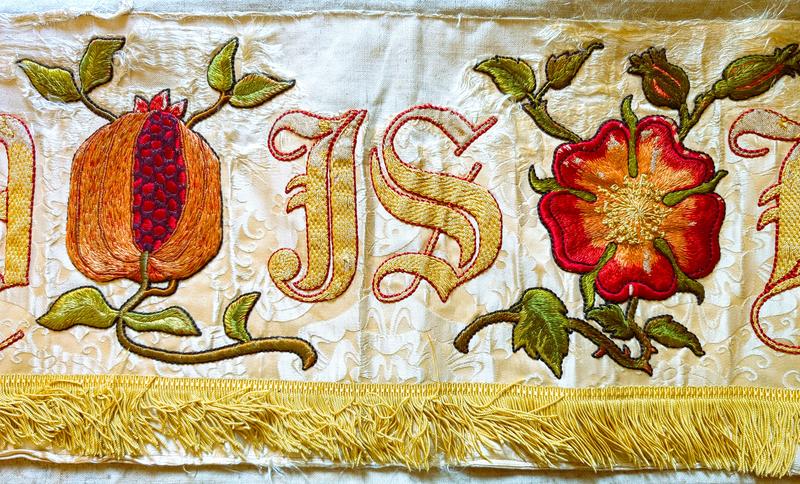“God is Love” proclaims an altar cloth preserved in the Archive. This beautifully embroidered piece was recently re-boxed and we took the opportunity to take a few photographs of it while it was out in the office. We know little about its origins although we do know that it was gifted to the Chapel in 1919 by Mrs Florence Hawksley Musgrave, a long-standing member of the congregation.
Unfortunately, we have no information about who designed or embroidered this beautiful piece. It may have been designed with an earlier decorative panel in mind which was intended for the space above the Communion Table (now occupied by The Last Supper). The altar cloth’s floral style brings to mind an unrealised design by Messrs Morris & Co. for a gesso panel featuring lilies and roses along with the inscription: “O Ye Spirits and Souls of the Righteous, Bless Ye the Lord.” The Morris & Co. panel was never produced and the design survives in sketch form and is held in the Huntington Library, California.
The altar cloth is remarked upon in Harold Begbie’s 1922 book Painted Windows: A Study in Religious Personality, written under the alias “A Gentleman with a Duster.” Begbie was a journalist and prolific author who used the book to explore the character and beliefs of leading Christian figures in early 20th-century Britain. One of the chapters focuses on Dr L.P. Jacks, Principal of Manchester College (1915–1931), who was a passionate believer that education was a force for both spiritual and social transformation.
Begbie’s chapter on Dr. L.P. Jacks offers a vivid picture of how perceptions of Manchester College had changed during the three decades since the college had arrived in Oxford. Once viewed as very much an outsider being a Nonconformist establishment, by the time this title was written the College had become a more accepted part of Oxford’s religious and cultural life. Begbie writes:
“To-day Manchester College, the seat of Unitarianism, stands on this same dissenting road, and thither the ladies of Oxford go up in great numbers to listen to the beautiful music which distinguishes the chapel service, the chapel itself already beautiful enough with windows by Burne-Jones.”
Begbie goes on to describe the “God is Love” altar cloth, noting not only the beauty of the piece but also commenting on how it reflects the Chapel's theological and spiritual openness:
“On the altar-cloth of this chapel are embroidered the words, GOD IS LOVE. No tables of stone flank that gentle altar, and no panelled creeds on the walls challenge the visitor to define his definitions. The atmosphere of the place is worship. The greatest of all Christ’s affirmations is reckoned enough.”

Detail of the Altar Cloth.